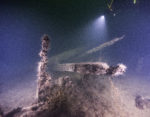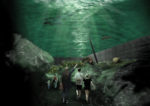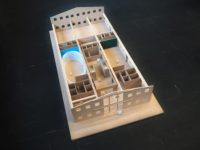 Archaeologists have discovered the wrecks of two ships in the Baltic Sea off Stockholm. That’s not unusual because the Baltic is a) really cold, and b) so saline that shipworm (and other assorted wood-eating critters), which can devour a wooden wreck in a matter of months, find it distinctly inhospitable. There are at least 100 intact ships on the Baltic Sea bed around Stockholm.
Archaeologists have discovered the wrecks of two ships in the Baltic Sea off Stockholm. That’s not unusual because the Baltic is a) really cold, and b) so saline that shipworm (and other assorted wood-eating critters), which can devour a wooden wreck in a matter of months, find it distinctly inhospitable. There are at least 100 intact ships on the Baltic Sea bed around Stockholm.
 What is unusual about the two that have just been discovered is their age. One is a medieval cog believed to date to the 14th or early 15th century. The other is from the 16th century. Most of the ships that sank in Stockholm’s waters date to the 17th and 18th centuries when Sweden’s naval fleet was in its fullest fulgor.
What is unusual about the two that have just been discovered is their age. One is a medieval cog believed to date to the 14th or early 15th century. The other is from the 16th century. Most of the ships that sank in Stockholm’s waters date to the 17th and 18th centuries when Sweden’s naval fleet was in its fullest fulgor.
Swedish National Maritime Museums (SNMM) divers found the wrecks just before Christmas while photographing and surveying the seabed for a new museum dedicated to the maritime archaeology of the Baltic Sea.
The wreckage from the Middle Ages is mostly submerged in mud and its details indicate that it is a cog, most likely from the 14th or 15th century. The ship is 23–25 meters in length and seven meters wide. It is likely to have had a mast with a square rig. More shipbuilding details indicate it being from the Middle Ages, such as protruding deck beams with unusually high knees and a simple anchor wheel. When cog ships were introduced on the seas they were a brand new, large and powerful type of ship that came to dominate large parts of the trade around the Baltic Sea for centuries.
The other shipwreck is estimated to be from the 16th century and still stands with the mast straight up and fully equipped. Some of the discoveries onboard include 20 barrels of osmond iron, kitchen utensils and tools. The extent of the iron found is unprecedented in
previous maritime findings. Osmond iron has largely built Sweden, but also supported countries around the Baltic Sea. Gustav Vasa wanted to ban the iron, and this happened later in 1604 when osmond iron was replaced with wrought iron.
The SNMM is working on a ground-breaking new approach to shipwreck archaeology and display: leaving them where they are. Instead of investing in the risky, time-consuming and prohibitively expensive recovery of shipwrecks as was done with the incomparable Vasa, known wrecks and ones still to be discovered will stay on the Baltic Sea floor where they will be explored by marine archaeologists. The new maritime archaeological museum, to be built next to the Vasa‘s museum home in Stockholm, will display artifacts and fragments of wrecks recovered in the dives rather than the ships themselves.  Visitors will still get a chance to see them, not in person after decades of conservation and restoration (always precarious), but as if they had been part of the diving team. The wonders of computer graphics and virtual reality technology make it possible to experience marine archaeological remains in their original context, in virtual situ, if you will.
Visitors will still get a chance to see them, not in person after decades of conservation and restoration (always precarious), but as if they had been part of the diving team. The wonders of computer graphics and virtual reality technology make it possible to experience marine archaeological remains in their original context, in virtual situ, if you will.
The Treasures of the Baltic Sea museum is scheduled to open in 2020.

